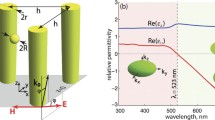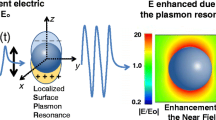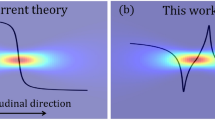Abstract
We calculate the radiation force on the nonlinear nanoparticle based on nonlinear Mie theory and Maxwell’s stress tensor method. The bistable radiation force can be observed and can be tuned through varying the nanoparticle’s size, the incident wavelength and the permittivity of the surrounding medium to obtain larger bistable region. Our results introduce nonlinear material to study the radiation force, which will have potential applications in optical manipulations and optical transportation.
Access provided by Autonomous University of Puebla. Download conference paper PDF
Similar content being viewed by others
Keywords
1 Introduction
Optical micromanipulation based on radiation force has attracted much attention in the past decades due to its wide applications in physics, chemistry and biology [1,2,3,4,5]. In the last century, Ashkin et al. have demonstrated the trapping of micron-size particles experimentally by radiation pressure of light [6]. It is interesting that light beam can not only push the object forward, but also pull the particle toward the source via a backward scattering force, called optical pulling force [7,8,9]. Meanwhile, the nonlinear materials have also attracted much interest [10, 11]. Nonlinear optical effects, such as optical bistability [12,13,14], have an important role in optical switching, optical transistor and optical modulation. In this paper, we study the radiation force on the nanoparticle and demonstrate that the radiation force exhibits bistability.
We adopt Maxwell’s stress tensor method to calculate the radiation force on the nonlinear nanoparticle. Considering the nanoparticle is nonlinear, we obtain the fields of the nanoparticle based on Mie theory and the self-consistent mean-field approximation method. The strong optical bistability of the radiation force for the nonlinear nanoparticles is demonstrated. The bistable region can be tuned by altering the nanoparticle’s size, the surrounding environment’s permittivity and the incident wavelength.
2 Theoretical Development
We firstly consider the linear nanoparticle with radius a, the relative permittivity εc and permeability \( \mu_{c} \), embedded in the medium of the relative permittivity εm and permeability \( \mu_{m} \). Based on the Lorenz–Mie scattering theory, the incident field, the scattered field and the field in the nanoparticle can be expressed as series expansions for transverse-magnetic (TM) and transverse-electric (TE) spherical modes [15, 16].
To study the nonlinear effects on optical materials, we consider the Kerr material with weak nonlinearity \( \widetilde{{\varepsilon_{c} }} = \varepsilon_{L} + \chi^{(3)} \left| {E_{c} } \right|^{2} \). And we adopt the mean-field approximation method and replace the nonlinear local field with the mean field, that is,
Substituting Eq. (1) into Lorenz-Mie scattering theory, we can deduce the nonlinear Lorenz-Mie scattering theory.
After solving the electric fields based on the above theory, we integrate the Maxwell’s stress tensor over the surface of the nanoparticle to calculate the radiation force on it. The field components are related with Maxwell’s stress tensor by the following expression
Then, the total time-averaged radiation force acting on the nanoparticle can be written as
where j is the outward normal vector of the surface of the nanoparticle. The normalized force is expressed as \( F_{0} = \pi a^{2} S_{\text{inc}} /c \), where \( S_{\text{inc}} \) is the power flow density of the incident wave.
3 Numerical Calculations
We now consider the nanoparticle with nonlinear relative permittivity [17], \( \widetilde{{\varepsilon_{c} }} = \varepsilon_{L} + \chi^{(3)} \left| {E_{c} } \right|^{2} \), where L = 2.2 and \( \chi^{(3)} = 4.4 \times 10^{ - 20} {\text{m}}^{2} /{\text{V}}^{2} \). We assume both the background and the nonlinear nanoparticle are non-magnetic with \( \mu_{m} = \mu_{c} = 1 \).
Firstly, we study the radiation force when the nanoparticle is illuminated by a plane wave with different wavelengths. In Fig. 1, it shows that the radiation force on the nonlinear nanoparticle exhibits bistable behavior. The radiation force first increases with the incident field 0 and then discontinuously jumps up to the upper branch upon reaching the switching-up threshold field \( E_{{0 - {\text{up}}}} (E_{{0 - {\text{up}}}} \approx 1.45 \times 10^{10} {\text{V}}/{\text{m}}\;{\text{for}}\;\lambda = 5 10\;{\text{nm}}) \). On the other hand, when the incident field 0 is decreased to the switching-down threshold field \( E_{{0 - {\text{down}}}} \approx 9.5 \times 10^{9} {\text{V}}/{\text{m}}\;{\text{for}}\;\lambda = 5 10\;{\text{nm}}) \), it discontinuously jumps down to the lower branch. Interestingly, we find that there is a maximum positive radiation force at the switching-down threshold field. And the bistable behavior becomes broader with increasing the wavelength.
Next, we plot the radiation force as a function of the permittivity of the surrounding medium to study the effect of the environment on the force. Figure 2 shows that increasing the permittivity, the bistable region becomes narrower. As shown in Fig. 2a, the maximum positive radiation force at the switching-down threshold field decreases with increasing the permittivity of the surrounding medium. However, for the permittivity larger than about 3, Fig. 2b shows a smoother line shape of the radiation force compared to Fig. 2a, and the radiation force at the switching-down threshold field is not the maximum positive value. In this case, one point worth emphasizing is that the radiation force firstly decreases and then increases at low incident electric field.
Then, we study the influence of the size of the nanoparticle on the bistable behavior. Figure 3a shows that increasing the size of the nanoparticle results in the bistable region of the radiation force becoming narrower due to the decrease of the switching-up threshold field. Meanwhile, the bistable region of the radiation force shifts downwards when the size of the particle increases. In Fig. 3b, we plot the radiation force versus the incident wavelength for a fixed input electric field 0 = 9 × 109 V/m. It shows that the bistable behavior is observable as well with varying the incident wavelength. The bistable behavior is similar to the case where the incident electric field is varied. However, the bistable region red shifts with increasing the size of the nanoparticle. This result provides the possibility of tuning the switching wavelength and switching threshold field of the radiation force via changing the size of the nanoparticles for potential applications.
Normal radiation force on the nanoparticle with different sizes. a Normalized radiation force as a function of the incident field 0 with = 500 nm. b Normalized radiation force as a function of wavelength with the incident electric field 0 = 9 × 109 V/m. The permittivity of the surrounding medium is m = 2.25
4 Conclusions
In conclusion, we calculate the radiation force on nonlinear nanoparticles and demonstrate optical bistability of the radiation force based on nonlinear Mie theory and Maxwell’s stress tensor method. When the optical intensity is sufficiently high, the nonlinearity of nanoparticles can give rise to bistable responses of radiation force. The bistable radiation force can be tuned by the nanoparticle’s size, the incident wavelength and the permittivity of the surrounding medium.
References
Antognozzi M, Bermingham CR, Harniman RL, Simpson S, Senior J, Hayward R et al (2016) Direct measurements of the extraordinary optical momentum and transverse spin- dependent force using a nano-cantilever. Nat Phys 12:731–735
Cheuk LW, Anderegg L, Augenbraun BL, Bao YC, Burchesky S, Ketterle W et al (2018) Lambda-enhanced imaging of molecules in an optical trap. Phys Rev Lett 121:083201
Reimann R, Doderer M, Hebestreit E, Diehl R, Frimmer M, Windey D et al (2018) GHz rotation of an optically trapped nanoparticle in vacuum. Phys Rev Lett 121:033602
Senaratne R, Rajagopal SV, Shimasaki T, Dotti PE, Fujiwara KM, Singh K et al (2018) Quantum simulation of ultrafast dynamics using trapped ultracold atoms. Nat Commun 9:2065
Wang HM, Wang L, Jakob DS, Xu XJG (2005) Tomographic and multimodal scattering-type scanning near-field optical microscopy with peak force tapping mode. Nat Commun 2018:9
Ashkin A (1970) Acceleration and trapping of particles by radiation pressure. Phys Rev Lett 24:156–159
Chen J, Ng J, Lin Z, Chan CT (2011) Optical pulling force. Nat Photon 5:531–534
Alaee R, Christensen J, Kadic M (2018) Optical pulling and pushing forces in bilayer PT- symmetric structures. Phys Rev Appl 9:014007
Zhu T, Cao Y, Wang L, Nie Z, Cao T, Sun F et al (2018) Self-induced backaction optical pulling force. Phys Rev Lett 120:123901
Nielsen MP, Shi XY, Dichtl P, Maier SA, Oulton RF (2017) Giant nonlinear response at a plasmonic nanofocus drives efficient four-wave mixing. Science 358:1179–1181
von Hoegen A, Mankowsky R, Fechner M, Forst M, Cavalleri A (2018) Probing the interatomic potential of solids with strong-field nonlinear phononics. Nature 555:79
Fink T, Schade A, Hofling S, Schneider C, Imamoglu A (2018) Signatures of a dissipative phase transition in photon correlation measurements. Nat Phys 14:365
Navarro-Urrios D, Capuj NE, Colombano MF, Garcia PD, Sledzinska M, Alzina F et al (2017) Nonlinear dynamics and chaos in an optomechanical beam. Nat Commun 8:14965
Pickup L, Kalinin K, Askitopoulos A, Hatzopoulos Z, Savvidis PG, Berloff NG et al (2018) Optical bistability under nonresonant excitation in spinor polariton condensates. Phys Rev Lett 120:225301
Born M, Wolf E (1999) Principles of optics: Electromagnetic theory of propagation, interference and diffraction of light. Cambridge University Press
Bohren CF, Huffman DR (1983) Absorption and scattering of light by small particles. Wiley, New York
Argyropoulos C, Chen PY, Monticone F, D’Aguanno G, Alu A (2012) Nonlinear plasmonic cloaks to realize giant all-optical scattering switching. Phys Rev Lett 108:263905
Funding
This work was supported by the National Science of Jiangsu Province (Grant No. BK20161210); the Qing Lan project, “333” project (Grant No. BRA2015353); Natural Science Foundation for the Youth of Jiangsu Province (No. BK20150306); Natural Science Foundation for Colleges and Universities in Jiangsu Province of China (No.15KJB140008).
Conflicts of Interest
The authors declare no conflicts of interest.
Author information
Authors and Affiliations
Corresponding author
Editor information
Editors and Affiliations
Rights and permissions
Copyright information
© 2021 Springer Nature Singapore Pte Ltd.
About this paper
Cite this paper
Chen, H.L., Huang, Y.Y., Gao, L. (2021). Nonlinear Radiation Force on Nanoparticles. In: Xu, L., Zhou, L. (eds) Proceedings of the 8th International Multidisciplinary Conference on Optofluidics (IMCO 2018). IMCO 2018. Lecture Notes in Electrical Engineering, vol 531. Springer, Singapore. https://doi.org/10.1007/978-981-13-3381-1_11
Download citation
DOI: https://doi.org/10.1007/978-981-13-3381-1_11
Published:
Publisher Name: Springer, Singapore
Print ISBN: 978-981-13-3380-4
Online ISBN: 978-981-13-3381-1
eBook Packages: EngineeringEngineering (R0)







